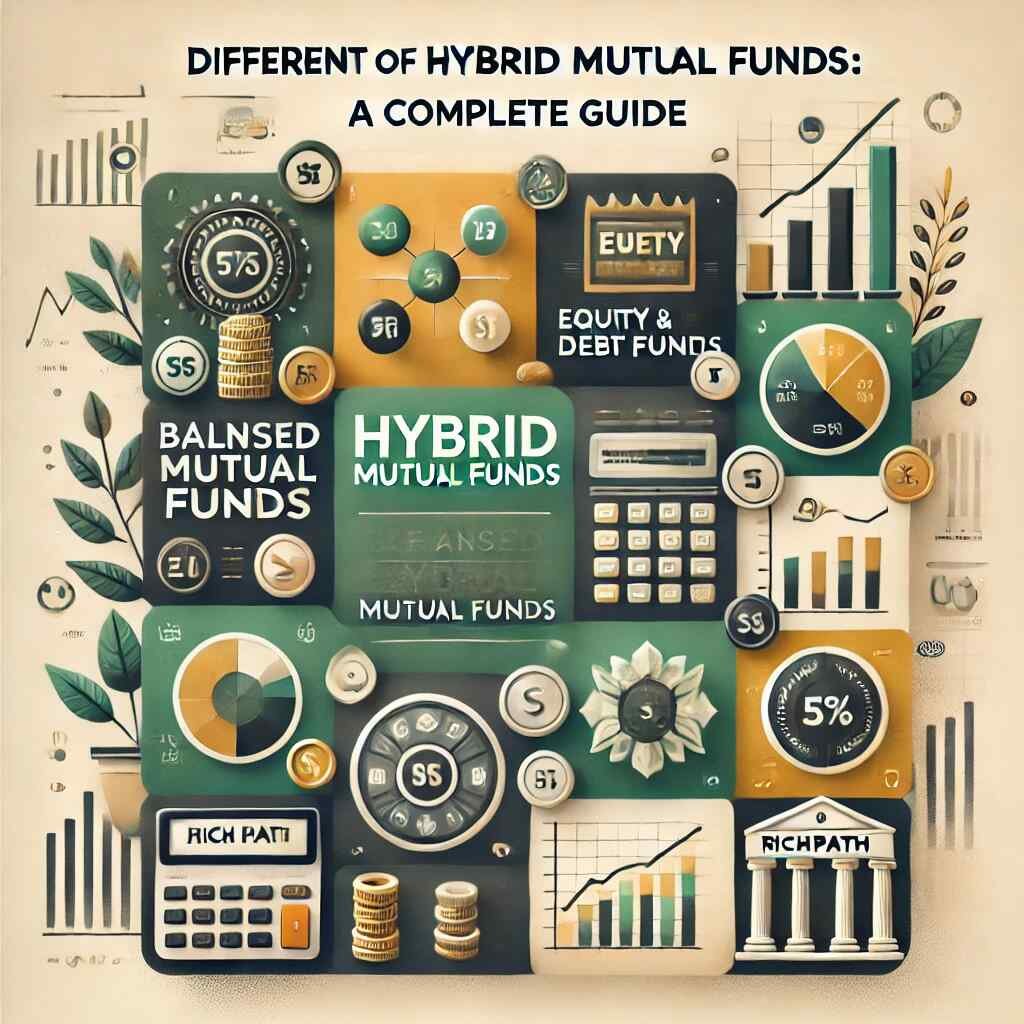Different Types of Hybrid Mutual Funds: A Complete Guide

Investing is all about balancing risk and reward to meet your financial goals. One way to achieve this balance is through hybrid mutual funds—investment vehicles designed to blend equity and debt instruments in a single portfolio. Hybrid mutual funds cater to diverse risk appetites and investment objectives, making them a popular choice among Indian investors.
In this detailed guide, we will explore the various types of hybrid mutual funds, their features, benefits, and how they can fit into your financial plan. Using relatable examples, this article will help you understand why hybrid mutual funds are worth considering for building a diversified and stable investment portfolio.
What Are the Types of Hybrid Mutual Funds?
Hybrid mutual funds are investment schemes that combine different asset classes, primarily equities and debt, to create a balanced portfolio. These funds aim to provide both growth and stability, depending on the allocation between the asset classes.
For instance, Ramesh, a 35-year-old teacher from Jaipur, wants to grow his wealth but is cautious about market volatility. A hybrid mutual fund can offer him a mix of equity for growth and debt for stability, meeting his risk tolerance and long-term goals.
Why Choose Hybrid Mutual Funds?
Hybrid funds are designed to address the needs of investors looking for:
- Diversification: Exposure to multiple asset classes reduces risk.
- Balanced Risk: Equity provides growth potential, while debt offers stability.
- Flexibility: Different types of hybrid funds cater to varying risk profiles.
- Professional Management: Experts actively manage the allocation to optimize returns.
Types of Hybrid Mutual Funds
SEBI categorizes hybrid mutual funds into six primary types, each with unique features and objectives.
1. Equity-Oriented Hybrid Funds
These funds invest predominantly in equities, with 65%-80% of their portfolio allocated to equity and the remaining to debt instruments.
Ideal For:
- Investors with a moderate to high risk tolerance.
- Individuals seeking capital appreciation over the long term.
Example:
Imagine Priya, a 28-year-old software engineer from Bengaluru, who wants to save for her dream home in 10 years. An equity-oriented hybrid fund could provide her the growth potential of equities while maintaining some stability through debt exposure.
2. Debt-Oriented Hybrid Funds
In contrast to equity-oriented funds, these funds focus on debt instruments, with 60%-80% of the portfolio in debt and the rest in equity.
Ideal For:
- Conservative investors who prioritize stability over high returns.
- Those nearing retirement or with short-term financial goals.
Example:
Anand, a 55-year-old government employee from Pune, wants to supplement his retirement corpus with steady returns. A debt-oriented hybrid fund can offer him consistent income with limited exposure to equity for modest growth.
3. Balanced Hybrid Funds
Balanced funds maintain an equal or nearly equal allocation to equity and debt (40%-60% each). These funds aim for a balance between risk and return.
Ideal For:
- Investors with moderate risk tolerance.
- Those seeking a mix of growth and stability.
Example:
Sunita, a 40-year-old business owner in Delhi, is saving for her daughter’s higher education in five years. A balanced hybrid fund offers her a blend of growth potential and stability.
4. Aggressive Hybrid Funds
These funds are similar to equity-oriented funds but with a higher tilt towards equities (up to 75%-90%).
Ideal For:
- Investors with a high-risk appetite.
- Long-term investors looking for significant capital appreciation.
Example:
Rahul, a 30-year-old entrepreneur from Mumbai, wants to build a retirement corpus over 20 years. An aggressive hybrid fund aligns with his risk-taking ability and long-term horizon.
5. Conservative Hybrid Funds
These funds are the safest among hybrid mutual funds, with a maximum allocation of 25% to equities and the rest to debt instruments.
Ideal For:
- Risk-averse investors.
- Those looking for better returns than traditional savings instruments like FDs.
Example:
Meera, a 60-year-old homemaker from Kolkata, wants to preserve her wealth while earning slightly better returns than a fixed deposit. A conservative hybrid fund is an ideal choice for her.
6. Dynamic Asset Allocation Funds
Also known as Balanced Advantage Funds (BAFs), these funds dynamically adjust their equity and debt allocation based on market conditions.
Ideal For:
- Investors who want a fund that adapts to market trends.
- Individuals seeking long-term capital appreciation with reduced volatility.
Example:
Vikram, a 45-year-old consultant from Chennai, prefers a fund that automatically adjusts allocations based on market trends. A dynamic asset allocation fund provides him peace of mind and steady returns.
Benefits of Hybrid Mutual Funds
- Diversification: Exposure to multiple asset classes reduces the impact of market volatility.
- Risk Management: A mix of equity and debt balances risk and rewards.
- Professional Management: Fund managers actively adjust allocations to maximize returns.
- Tax Efficiency: Equity-oriented hybrid funds benefit from favorable taxation.
Factors to Consider Before Investing
- Risk Appetite: Choose a fund type that aligns with your risk tolerance.
- Investment Horizon: Match the fund’s objective with your financial goals.
- Expense Ratio: Lower expense ratios enhance overall returns.
- Fund Manager Expertise: Look for experienced fund managers with a strong track record.
Tax Implications
Hybrid funds are taxed based on their equity and debt composition:
- Equity-Oriented Funds:
- Short-term gains (holding < 1 year): Taxed at 15%.
- Long-term gains (> ₹1 lakh): Taxed at 10%.
- Debt-Oriented Funds:
- Short-term gains (holding < 3 years): Taxed at the investor’s income tax slab rate.
- Long-term gains: Taxed at 20% with indexation benefits.
How to Start Investing in Hybrid Funds
- Identify Your Goals: Define your financial objectives and timeline.
- Assess Risk Tolerance: Choose a fund type based on your comfort level with risk.
- Research Funds: Evaluate historical performance, expense ratio, and fund manager reputation.
- Use SIPs: Start a Systematic Investment Plan (SIP) to invest regularly and benefit from rupee cost averaging.
- Track Performance: Periodically review the fund’s performance and adjust your portfolio as needed.
Conclusion
Hybrid mutual funds offer a perfect blend of growth and stability, catering to a wide range of investor profiles. Whether you’re a cautious retiree like Meera or an ambitious entrepreneur like Rahul, there’s a hybrid fund designed for your financial needs.
By carefully selecting the right type of hybrid fund and aligning it with your goals, you can build a diversified and resilient investment portfolio that withstands market fluctuations while delivering consistent returns.
Start your hybrid fund journey today and take a significant step toward achieving your long-term financial goals!
For expert financial insights, visit Rich Path. and start your investment journey today! 🚀
Read more –
What is a Flexi Cap Mutual Fund? A Beginner’s Guide to Flexible Investing
Best Flexi Cap Mutual Funds to Invest in 2025
Flexi Cap Mutual Funds vs Multi Cap Mutual Funds
Parag Parikh Flexi Cap Mutual Fund: Last 5, 10, 15 Years Analysis and Future Predictions
Flexi Cap Mutual Funds: 1-Step solution
HDFC Flexi Cap Fund Full Analysis: Unlock Growth Potential with This Dynamic Investment








